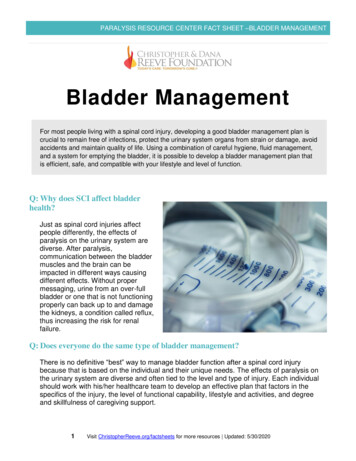
Transcription
A guide to self-catheterizationAchievingindependence
IntroductionThis brochure is provided byBard, a leading provider ofurology products since 1907.The best source of informationis your medical careprofessional; be sure to discussyour individual requirementsand questions with him or her.It is our hope that theinformation in this booklet,while not intended to replaceadvice from your medicalAchieving Independence Learning to Self-CatheterizeSelf-catheterization increases yourfreedom and independence by allowingyou to drain your bladder at regularintervals. Self-catheterization mayalso be referred to as intermittentcatheterization.The process consists of placing a thin,flexible tube (catheter) through theurethra into the bladder to drain theurine. This will need to be performedevery three to six hours, based uponyour fluid intake.Employing proper hygiene andtechniques will not only decreasethe chance of contracting a urinarytract infection, it will also reduce skinirritation and discomfort. While initiallythe self-catheterization process may bedifficult, it will quickly become easieras you become accustomed to theprocedure.Your Urinary Tract SystemIn order to properly performcatheterization, it is helpful tounderstand the location of the majorurological care professional, will provehelpful as you integrate selfcatheterization into your hraRectumMale
Preparing for catheterization:Steps to Intermittent Catheterization – FemaleYou’ll want to review the self-catheterizationprocedure with your doctor, nurse or therapistso you’re totally familiar with all the equipmentand steps in the process. Choose a quiet, cleanlocation which allows privacy.1. P osition yourself comfortably with thighs spreadapart. For many women, it is preferred to sit onthe toilet or in a chair across from the toilet.Remember to always inspect thecatheter before use. Do not usethe product if the catheter orthe packaging is damaged. Alwayswash your hands with soapand water, or with a waterless,antibacterial cleanser.Note – Taking intoaccount slightvariations, the process described isapplicable for mostself-catheterizationproducts.Steps to IntermittentCatheterization – Male1. P osition yourself in front of the toilet or in achair across from the toilet.2. C lean the opening to the urethra andsurrounding area with soap and water or amoist towelette.3. I f the catheter is not pre-lubricated,generously apply lubricant. Use a water solublelubricant and lubricate the tip and the first 6” ofthe catheter.4. U sing your non-dominant hand, hold the penisstraight up from the body at a 60 to 70 degreeangle. Slowly and gently insert the catheterinto the urethra until the urine begins to flow(approximately 6-8”).2. C lean the opening to the urethra andsurrounding area by holding the outer labiaapart and cleaning with soap and water or amoist towelette. Wipe the urethral opening tothe bladder from front to back to avoid fecalcontamination.3. L ubricate the tip and the first 2” of the catheterwith a water soluble lubricant. (Lubricant maybe optional for women.)4. S pread the inner labia and advance theinsertion tip into the urethra. Release the innerlabia. Slowly and gently insert the catheterinto the urethra until the urine begins to flow(approximately 1-1.5”).Completing Catheterization –Male and Female5. Allow urine to flow freely until bladder is empty.6. W hen urine stops, begin to withdrawthe catheter. It is recommended thatyou slowly rotate the catheter as you withdrawit and stop each time more urine drains out.7. C heck the color, odor and clarity of the urine tobe aware of any changes that you may need toreport to your doctor or nurse.Tips:
Male Catheterization With the Bard Touchless Plus Catheter:1. W ith one hand, squeeze tabs to keepthe insertion tip in place as you use the pull ringto remove cap. Save cap to close the bag.2. S lide the pre-lubricated catheter halfway intothe insertion tip. You can do this through thebag so your hands do not touch the catheter.3. C lean the opening to the urethra andthe surrounding area with the providedpovidone-iodine swabs.4. H olding the penis on the sides, advance theinsertion tip into the urethra no further than thebase of the insertion tip.5. Y our catheter has a control guide tohelp stabilize the catheter in the urethra. Grabthe guide through the bag with your nondominant hand. Use your dominant hand tograsp the catheter tube through the bag.6. P ush the catheter into the urethra. Use a short,repetitive pushing motion. Continue to insertthe catheter until it reaches the bladder andurine starts to flow.Control Guide7. A llow urine to flowfreely until bladderis empty or bag isfilled. Make certainthe control guideis elevated at leastfour inches abovelower portion of thebag. Precaution – it isrecommended that youhold the collection bag,as the weight of the urinecould cause the catheterto separate from thecollection bag.8. W ithdraw the catheter from the urethra,stopping about three times to let any remainingurine drain. Pinch the end of the catheter priorto pulling it out to keep urine from spilling outof the catheter.9. R emove the rest of the catheter from thecollection bag by pulling it through theinsertion tip. Note – the catheter is designed topass through the insertion tip.10. C lose the filled collection bag by replacing thecap over the insertion tip. Make sure the capsnaps on securely.11. When ready, you can remove the insertion tipto empty the bag. Dispose of the empty bagand packaging in a waste recepticle. Washyour hands with soap and water.Female Catheterization With the Bard Touchless Plus Catheter:1. W ith one hand, squeeze tabs to keepthe insertion tip in place as you use the pull ringto remove cap. Save cap to close the bag.2. S lide the pre-lubricated catheter halfway intothe insertion tip. You can do this through thebag so your hands do not touch the catheter.3. Clean the opening to the urethra andsurrounding area by holding the outer labiaapart and cleaning with theprovided povidone-iodine swabs. Wipe theurethra opening to the bladder, from front toback to avoid fecal contamination.4. S pread the inner labia and advance theinsertion tip into the urethra no further than thebase of the insertion tip. Release the inner labia.5. Y our catheter hasa control guide to Labiahelp stabilize thecatheter in theurethra. Grasp thatthrough the bagwith your nondominant hand.Vagina OrificeUse your dominanthand to graspthe catheter tubethrough the bag.UrethraControl Guide6. P ush the catheter into the urethra, aimingupwards towards the navel. Use a short,repetitive pushing motion. Continue to insertthe catheter until it reaches the bladder andurine starts to flow.
Introducing the Bard Touchless Plus CatheterOne of the most commonproblems with catheterizationis urinary tract infections.Talk with your doctor if youare having recurring problemsabout the possibility ofswitching to a closed systemdesign, such as the Bard Touchless Plus IntermittentCatheter system.The Bard Touchless Plus IntermittentCatheter SystemThe Bard Touchless Plus Intermittent Cathetersystem has what is known as a “closedsystem” designed to help reduce the risk ofurinary tract infections. Among the featuresthat you’ll find helpful are: 1 Insertion tip correctly positionsthe catheter in the urethra to helpreduce UTIs. 2 Catheter control guide allows control of catheter insertion with the touchof a finger. 3 Tapered neck design decreasescuts and scrapes associated withsharp corners. 4 Catheter cap has pull ring for easy removal– especially for people withlimited dexterity. 5 Pre-lubricated catheter reducesdiscomfort during insertion.5 6 Large 1100cc collection bag isdurable, virtually eliminating therisk of leaks. 4 Choice of red rubber or vinyl1catheters based upon yourpreference and needs. Variety of catheter sizes,2and available with or without3accessories.Using the Bard Touchless PlusIntermittent Catheter SystemTo order a free instructional videoor get answers to questions aboutcatheterization or products, callBard Care at 800.243.3315 or visitwww.bardcare.com.You’ll want to review the procedurewith your doctor, nurse or therapistso you’re totally familiar with all theequipment and the steps in theself-catheterization procedure.Choose a quiet, clean location whichallows privacy.The first step is to open the kit andremove the contents, placing themon a surface that is clean ordisposable (such as paper towels).Then wash your hands with soap andwater, or with a waterless, antibacterialcleanser.6
A guide to self-catheterization with theBard Touchless Plus intermittent catheter systemAchievingindependence
5. Your catheter has a control guide to help stabilize the catheter in the urethra. Grab the guide through the bag with your non-dominant hand. Use your dominant hand to grasp the catheter tube through the bag. 6. Push the catheter into the urethra. Use a short, repetitive pushing motion. Continue to insert the catheter until it reaches the .










